Atherectomy for peripheral arterial disease
- PMID: 32990327
- PMCID: PMC8513671
- DOI: 10.1002/14651858.CD006680.pub3
Atherectomy for peripheral arterial disease
Abstract
Background: Symptomatic peripheral arterial disease (PAD) has several treatment options, including angioplasty, stenting, exercise therapy, and bypass surgery. Atherectomy is an alternative procedure, in which atheroma is cut or ground away within the artery. This is the first update of a Cochrane Review published in 2014.
Objectives: To evaluate the effectiveness of atherectomy for peripheral arterial disease compared to other established treatments.
Search methods: The Cochrane Vascular Information Specialist searched the Cochrane Vascular Specialised Register, Cochrane Central Register of Controlled Trials (CENTRAL), MEDLINE, Embase, Cumulative Index to Nursing and Allied Health Literature (CINAHL) and Allied and Complementary Medicine (AMED) databases, and the World Health Organization International Clinical Trials Registry Platform and ClinicalTrials.gov trials registers to 12 August 2019.
Selection criteria: We included all randomised controlled trials that compared atherectomy with other established treatments. All participants had symptomatic PAD with either claudication or critical limb ischaemia and evidence of lower limb arterial disease.
Data collection and analysis: Two review authors screened studies for inclusion, extracted data, assessed risk of bias and used GRADE criteria to assess the certainty of the evidence. We resolved any disagreements through discussion. Outcomes of interest were: primary patency (at six and 12 months), all-cause mortality, fatal and non-fatal cardiovascular events, initial technical failure rates, target vessel revascularisation rates (TVR; at six and 12 months); and complications.
Main results: We included seven studies, with a total of 527 participants and 581 treated lesions. We found two comparisons: atherectomy versus balloon angioplasty (BA) and atherectomy versus BA with primary stenting. No studies compared atherectomy with bypass surgery. Overall, the evidence from this review was of very low certainty, due to a high risk of bias, imprecision and inconsistency. Six studies (372 participants, 427 treated lesions) compared atherectomy versus BA. We found no clear difference between atherectomy and BA for the primary outcomes: six-month primary patency rates (risk ratio (RR) 1.06, 95% confidence interval (CI) 0.94 to 1.20; 3 studies, 186 participants; very low-certainty evidence); 12-month primary patency rates (RR 1.20, 95% CI 0.78 to 1.84; 2 studies, 149 participants; very low-certainty evidence) or mortality rates (RR 0.50, 95% CI 0.10 to 2.66, 3 studies, 210 participants, very low-certainty evidence). One study reported cardiac failure and acute coronary syndrome as causes of death at 24 months but it was unclear which arm the participants belonged to, and one study reported no cardiovascular events. There was no clear difference when examining: initial technical failure rates (RR 0.48, 95% CI 0.22 to 1.08; 6 studies, 425 treated vessels; very low-certainty evidence), six-month TVR (RR 0.51, 95% CI 0.06 to 4.42; 2 studies, 136 treated vessels; very low-certainty evidence) or 12-month TVR (RR 0.59, 95% CI 0.25 to 1.42; 3 studies, 176 treated vessels; very low-certainty evidence). All six studies reported complication rates (RR 0.69, 95% CI 0.28 to 1.68; 6 studies, 387 participants; very low-certainty evidence) and embolisation events (RR 2.51, 95% CI 0.64 to 9.80; 6 studies, 387 participants; very low-certainty evidence). Atherectomy may be less likely to cause dissection (RR 0.28, 95% CI 0.14 to 0.54; 4 studies, 290 participants; very low-certainty evidence) and may be associated with a reduction in bailout stenting (RR 0.26, 95% CI 0.09 to 0.74; 4 studies, 315 treated vessels; very low-certainty evidence). Four studies reported amputation rates, with only one amputation event recorded in a BA participant. We used subgroup analysis to compare the effect of plain balloons/stents and drug-eluting balloons/stents, but did not detect any differences between the subgroups. One study (155 participants, 155 treated lesions) compared atherectomy versus BA and primary stenting, so comparison was extremely limited and subject to imprecision. This study did not report primary patency. The study reported one death (RR 0.38, 95% CI 0.04 to 3.23; 155 participants; very low-certainty evidence) and three complication events (RR 7.04, 95% CI 0.80 to 62.23; 155 participants; very low-certainty evidence) in a very small data set, making conclusions unreliable. We found no clear difference between the treatment arms in cardiovascular events (RR 0.38, 95% CI 0.04 to 3.23; 155 participants; very low-certainty evidence). This study found no initial technical failure events, and TVR rates at six and 24 months showed little difference between treatment arms (RR 2.27, 95% CI 0.95 to 5.46; 155 participants; very low-certainty evidence and RR 2.05, 95% CI 0.96 to 4.37; 155 participants; very low-certainty evidence, respectively).
Authors' conclusions: This review update shows that the evidence is very uncertain about the effect of atherectomy on patency, mortality and cardiovascular event rates compared to plain balloon angioplasty, with or without stenting. We detected no clear differences in initial technical failure rates or TVR, but there may be reduced dissection and bailout stenting after atherectomy although this is uncertain. Included studies were small, heterogenous and at high risk of bias. Larger studies powered to detect clinically meaningful, patient-centred outcomes are required.
Copyright © 2020 The Cochrane Collaboration. Published by John Wiley & Sons, Ltd.
Conflict of interest statement
BW: none known GA: has declared that he has received money from NIHR for an academic clinical fellowship, but this does not cause any conflict of interest with this review. RR: none known RH: none known CT: none known
Figures
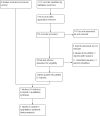
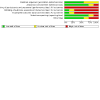
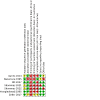
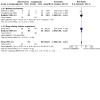

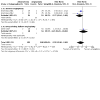
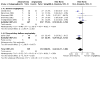
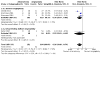


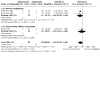
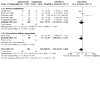
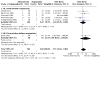









Update of
-
Atherectomy for peripheral arterial disease.Cochrane Database Syst Rev. 2014 Mar 17;(3):CD006680. doi: 10.1002/14651858.CD006680.pub2. Cochrane Database Syst Rev. 2014. Update in: Cochrane Database Syst Rev. 2020 Sep 29;9:CD006680. doi: 10.1002/14651858.CD006680.pub3. PMID: 24638972 Updated.
References
References to studies included in this review
Dattilo 2014 {published data only}
-
- Dattilo R, Himmelstein SI, Cuff RF. The COMPLIANCE 360 trial: a randomized, prospective, multicenter, pilot study comparing acute and long-term results of orbital atherectomy to balloon angioplasty for calcified femoropopliteal disease. Journal of Invasive Cardiology 2014;26(8):355-60. - PubMed
Nakamura 1995 {published data only}
-
- Nakamura S, Conroy RM, Gordon IL, Deutsch LS, Maheswaran B, Antone CS, et al. A randomized trial of transcutaneous extraction atherectomy in femoral arteries: intravascular ultrasound observations. Journal of Clinical Ultrasound 1995;23(8):461-71. - PubMed
Ott 2017 {published data only}
-
- NCT00986752. Efficacy study of stenting, paclitaxel eluting balloon or atherectomy to treat peripheral artery disease (ISAR-STATH). clinicaltrials.gov/show/NCT00986752 (first posted 30 September 2009).
-
- Ott I, Cassese S, Groha P, Steppich B, Hadamitzky M, Ibrahim T, et al. Randomized comparison of Paclitaxel-eluting balloon and stenting versus plain balloon plus stenting versus directional atherectomy for femoral artery disease (ISAR-STATH). Circulation 2017;135(23):2218-26. - PubMed
Shammas 2011 {published data only}
-
- Coiner D, Dippel E, Jerin M, Shammas G, Shammas N. Percutaneous lower extremity arterial interventions using balloon angioplasty versus silverhawk atherectomy: results of the SMARTHAWK randomized trial. Catheterization and Cardiovascular Interventions 2009;73:S21.
-
- Coiner D, Dippel E, Jerin M, Shammas G, Shammas N. Walking impairment questionnaire, ankle-brachial index and Rutherford-Baker class in patients undergoing angioplasty versus Silverhawk atherectomy: results from the smarthawk randomized trial. Catheterization and Cardiovascular Interventions 2009;73:S42.
-
- Shammas NW, Coiner D, Shammas GA, Dippel EJ, Christensen L, Jerin M. Percutaneous lower-extremity arterial interventions with primary balloon angioplasty versus Silverhawk atherectomy and adjunctive balloon angioplasty: randomized trial. Journal of Vascular and Interventional Radiology 2011;22(9):1223-8. - PubMed
Shammas 2012 {published data only}
-
- Shammas NW, Lam R, Mustapha J, Ellichman J, Aggarwala G, Rivera E, et al. Comparison of orbital atherectomy plus balloon angioplasty vs. balloon angioplasty alone in patients with critical limb ischemia: results of the calcium 360 randomized pilot trial. Journal of Endovascular Therapy 2012;19(4):480-8. - PubMed
-
- Shammas NW, Lam R, Mustapha J, Ellichman J, Aggarwala G, Rivera E. Orbital atherectomy and balloon angioplasty vs. balloon angioplasty alone in critical limb ischemia: results of the CALCIUM 360 trial. Journal of Vascular and Interventional Radiology 2013;24(1):145.e2-3.
-
- Shammas NWM. Six-month outcomes of prospective, randomized CALCIUM 360 study demonstrate the advantages of plaque modification with the orbital technology versus treatment with balloon angioplasty in patients with critical limb ischemia. Journal of the American College of Cardiology 2011;58(20 Suppl 1):B154.
Vroegindeweij 1995 {published data only}
-
- Tielbeek AV, Vroegindeweij D, Buth J, Landman GH. Comparison of balloon angioplasty and Simpson atherectomy for lesions in the femoropopliteal artery: angiographic and clinical results of a prospective randomized trial. Journal of Vascular and Interventional Radiology 1996;7(6):837-44. - PubMed
-
- Tielbeek AV, Vroegindeweij D, Buth J, Schol FP, Mali WP. Comparison of intravascular ultrasonography and intraarterial digital subtraction angiography after directional atherectomy of short lesions in femoropopliteal arteries. Journal of Vascular Surgery 1996;23(3):436-45. - PubMed
-
- Vroegindeweij D, Kemper FJ, Tielbeek AV, Buth J, Landman G. Recurrence of stenoses following balloon angioplasty and Simpson atherectomy of the femoro-popliteal segment. A randomised comparative 1-year follow-up study using colour flow duplex. European Journal of Vascular Surgery 1992;6(2):164-71. - PubMed
-
- Vroegindeweij D, Kemper FJ, Tielbeek AV, Landman G, Buth J. Recurrence of stenoses following balloon angioplasty and atherectomy of the femoropopliteal segment. A randomized comparative one year follow-up study using color flow duplex. In: European Society for Vascular Surgery 5th Annual Meeting. Warsaw, Poland, 1991:72.
-
- Vroegindeweij D, Tielbeek AV, Buth J, Schol FP, Hop WC, Landman GH. Directional atherectomy versus balloon angioplasty in segmental femoropopliteal artery disease: two-year follow-up with color-flow duplex scanning. Journal of Vascular Surgery 1995;21(2):255-68; discussion 268-9. - PubMed
Zeller 2017 {published data only}
-
- NCT01366482. Atherectomy followed by a drug coated balloon to treat peripheral arterial disease (DEFINITIVE AR). clinicaltrials.gov/show/NCT01366482 (first posted 6 June 2011).
-
- Zeller T, Langhoff R, Rocha-Singh KJ, Jaff MR, Blessing E, Amann-Vesti B, et al. Directional atherectomy followed by a Paclitaxel-coated balloon to inhibit restenosis and maintain vessel patency: twelve-month results of the DEFINITIVE AR Study. Circulation: Cardiovascular Interventions 2017;10(9):e004848. [DOI: 10.1161/circinterventions.116.004848] - DOI - PMC - PubMed
References to studies excluded from this review
Brodmann 2013 {published data only}
-
- Brodmann M, Rief P, Froehlich H, Dorr A, Gary T, Eller P, et al. Neointimal hyperplasia after Silverhawk atherectomy versus percutaneous transluminal angioplasty (PTA) in femoropopliteal stent reobstructions: a controlled, randomized pilot trial. Cardiovascular and Interventional Radiology 2013;36(1):69-74. - PubMed
Del Giudice 2014 {published data only}
-
- Del Giudice C. Synergistic strategy of laser atherectomy and drug-eluting balloon angioplasty for treatment of in-stent restenosis in the superficial femoral artery: a randomised study. In: EuroPCR Abstracts and Posters. 2014. [DOI: 10.1007/978-1-4471-5220-0_14] - DOI
Dippel 2015 {published data only}
-
- Dippel EJ, Makam P, Kovach R, George JC, Patlola R, Metzger DC, et al. Randomized controlled study of excimer laser atherectomy for treatment of femoropopliteal in-stent restenosis: Initial results from the EXCITE ISR Trial (EXCImer laser randomized controlled study for treatment of FemoropopliTEal in-stent restenosis). JACC: Cardiovascular Interventions 2015;8(1):95-101. - PubMed
-
- Dippel EJ, Makam P, Kovach RC, George JC, Patlola RR, Metzger DC, et al. Excite ISR: a prospective, randomized controlled trial of excimer laser atherectomy vs balloon angioplasty for the treatment of femoropopliteal in-stent restenosis. Journal of the American College of Cardiology 2014;64(11 suppl 1):B155.
Gabrielli 2012 {published data only}
-
- Gabrielli R, Rosati MS, Vitale S, Baciarello G, Siani A, et al. Randomized controlled trial of remote endarterectomy versus endovascular intervention for TransAtlantic Inter-Society Consensus II D femoropopliteal lesions. Journal of Vascular Surgery 2012;56(6):1598-605. - PubMed
Gandini 2013 {published data only}
-
- Gandini R, Del Giudice C, Merolla S, Morosetti D, Pampana E, Simonetti G. Treatment of chronic SFA in-stent occlusion with combined laser atherectomy and drug-eluting balloon angioplasty in patients with critical limb ischemia: a single-center, prospective, randomized study. Journal of Endovascular Therapy 2013;20:805-14. - PubMed
Gisbertz 2009 {published data only}
-
- Gisbertz SS, Ramzan M, Tutein Nolthenius RP, Laan L, Overtoom TT, Moll FL, et al. Short-term results of a randomized trial comparing remote endarterectomy and supragenicular bypass surgery for long occlusions of the superficial femoral artery (the REVAS Trial). European Journal of Vascular and Endovascular Surgery 2009;37(1):68-76. - PubMed
-
- Gisbertz SS, Tutein Nolthenius RP, Borst GJ, Laan L, Overtoom TT, Moll FL, et al. Remote endarterectomy versus supragenicular bypass surgery for long occlusions of the superficial femoral artery: medium-term results of a randomized controlled trial (the REVAS trial). Annals of Vascular Surgery 2010;24(8):1015-23. - PubMed
NCT02730234 {published data only}
-
- NCT02730234. JetStream atherectomy for the treatment of in-stent restenosis (JET-ISR). clinicaltrials.gov/show/NCT02730234 (first received 6 April 2016).
NCT02832024 {published data only}
-
- NCT02832024. Clinical study of stent versus direct atherectomy versus angioplasty to treat lower limb in-stent restenosis. clinicaltrials.gov/ct2/show/NCT02832024 (first received 13 July 2016).
Schwindt 2017 {published data only}
-
- Schwindt AG, Bennett JG Jr, Crowder WH, Dohad S, Janzer SF, George JC, et al. Lower extremity revascularization using optical coherence tomography-guided directional atherectomy: final results of the evaluatIon of the pantheris optIcal coherence tomography imaging atherectomy system for use in the peripheral vasculature (VISION) Study. Journal of Endovascular Therapy 2017;24(3):355-66. - PubMed
References to ongoing studies
ChiCTR‐IOR‐17012486 {published data only}
-
- ChiCTR-IOR-17012486x. Drug-coated balloon versus drug-coated balloon with atherectomy for the treatment of femoral-popliteal calcified occlusive disease: a randomized, controlled and prospective study. www.chictr.org.cn/showprojen.aspx?proj=21256 (first received 28 August 2017).
Martinsen 2015 {published data only}
-
- Martinsen BJ, Weber SA, Pietzsch ML, Behrens A, Weatherspoon M, Igyarto Z, et al. Economic study design for the optimize study on orbital atherectomy and drug-coated balloon devices for the treatment of below-the-knee peripheral arterial disease. Value in Health 2015;18(7):A723.
NCT01579123 {published data only}
-
- NCT01579123. Laser atherectomy versus angioplasty for the treatment of critical limb ischemia. clinicaltrials.gov/ct2/show/NCT01579123 (first received 17 April 2012).
NCT01763476 {published data only}
-
- NCT01763476. Atherectomy and drug-coated balloon angioplasty in treatment of long infrapopliteal lesions. clinicaltrials.gov/ct2/show/NCT01763476 (first received 9 January 2013).
NCT02514460 {published data only}
-
- NCT02514460. Clinical study of stent versus direct atherectomy to treat lower limb ischemia. clinicaltrials.gov/ct2/show/NCT02514460 (first received 3 August 2015).
NCT02517827 {published data only}
-
- NCT02517827. Percutaneous intervention versus surgery in the treatment of common femoral artery lesions. clinicaltrials.gov/ct2/show/NCT02517827 (first received 7 August 2015).
NCT02561299 {published data only}
-
- NCT02561299. Orbital vessel preparation to maximize dcb efficacy in calcified below the knee (BTK) lesions - a pilot study. clinicaltrials.gov/ct2/show/NCT02561299 (first received 28 September 2015).
NCT02840786 {published data only}
-
- NCT02840786. Clinical study of stent versus direct atherectomy to treat arteriosclerosis occlusive disease of lower extremity. clinicaltrials.gov/ct2/show/NCT02840786 (first received 26 July 2016).
NCT03206762 {published data only}
-
- NCT03206762. JET-RANGER Trial - JETStream atherectomy with adjunctive Paclitaxel-coated balloon angioplasty vs plain old balloon angioplasty followed by Paclitaxel-coated balloon. clinicaltrials.gov/ct2/show/NCT03206762 (first received 2 July 2017).
NCT03380650 {published data only}
-
- NCT03380650. Study of DA+LDD in the treatment of femoropopliteal occlusive disease. clinicaltrials.gov/ct2/show/NCT03380650 (first received 21 December 2017).
NCT03495453 {published data only}
-
- NCT03495453. Directional versus orbital atherectomy plaque modification and luminal area assessment of the femoro-popliteal artery via intravascular ultrasound. clinicaltrials.gov/ct2/show/NCT03495453 (first received 12 April 2018).
Additional references
Abdel‐Wahab 2013
-
- Abdel-Wahab M, Richardt G, Joachim Buttner H, Toelg R, Geist V, Meinertz T, et al. High-speed rotational atherectomy before paclitaxel-eluting stent implantation in complex calcified coronary lesions: the randomized ROTAXUS (Rotational Atherectomy Prior to Taxus Stent Treatment for Complex Native Coronary Artery Disease) trial. ACC Cardiovascular Intervention January 2013;6:10-9. - PubMed
Akkus 2014
Briguori 2003
-
- Briguori C, DiMario C, Colombo A. Distal embolization during directional coronary atherectomy. Journal of Invasive Cardiology 2003;15(8):448-50. - PubMed
Dake 2011
-
- Dake MD, Ansel GM, Jaff MR, Ohki T, Saxon RR, Smouse HB, et al, Zilver PTX Investigators. Paclitaxel-eluting stents show superiority to balloon angioplasty and bare metal stents in femoropopliteal disease: twelve-month Zilver PTX randomized study results. Circulation. Cardiovascular Interventions 2011;4(5):495-504. - PubMed
DerSimonian 1986
-
- DerSimonian R, Laird N. Meta-analysis in clinical trials. Controlled Clinical Trials 1986;7(3):177-88. - PubMed
ERBAC 1997
-
- Reifart N, Vandormael M, Krajcar M, Göhring S, Preusler W, Schwarz F, et al. Randomized comparison of angioplasty of complex coronary lesions at a single center. Excimer Laser, Rotational Atherectomy, and Balloon Angioplasty Comparison (ERBAC) Study. Circulation 1997;96(1):91-8. - PubMed
European Consensus Document 1989
-
- European Consensus. European consensus on critical limb ischaemia. Lancet 1989;333(8640):737-8.
Fowkes 1998
Fowkes 2008
Frans 2012
-
- Frans FA, Bipat S, Reekers JA, Legemate DA, Koelemay MJ. Systematic review of exercise training or percutaneous transluminal angioplasty for intermittent claudication. British Journal of Surgery 2012;99(1):16-28. - PubMed
Fu 2015
Garcia 2009
-
- Garcia LA, Lyden SP. Atherectomy for infrainguinal peripheral artery disease. Journal of Endovascular Therapy 2009;16(2 Suppl 2):II105-15. - PubMed
Guyatt 2008
Heuser 2008
-
- Heuser RR. Treatment of lower extremity vascular disease: the Diamondback 360 degrees Orbital Atherectomy System. Expert Review of Medical Devices 2008;5(3):279-86. - PubMed
Higgins 2011
-
- Higgins JP, Green S, editor(s). Cochrane Handbook for Systematic Reviews of Interventions Version 5.1.0 (updated March 2011). The Cochrane Collaboration, 2011. Available from handbook.cochrane.org.
Indes 2010
-
- Indes JE, Shah HJ, Jonker FH, Ohki T, Veith FJ, Lipsitz EC. Subintimal angioplasty is superior to SilverHawk atherectomy for the treatment of occlusive lesions of the lower extremities. Journal of Endovascular Therapy 2010;17(2):243-50. - PubMed
Katsanos 2018
-
- Katsanos K, Spiliopoulos S, Kitrou P, Krokidis M, Karnabatidis D. Risk of death following application of paclitaxel-coated balloons and stents in the femoropopliteal artery of the leg: a systematic review and meta-analysis of randomized controlled trials. Journal of American Heart Association 2018;7(24):e011245. - PMC - PubMed
Kayssi 2016
-
- Kayssi A, Al-Atassi T, Oreopoulos G, Roche-Nagle G, Tan KT, Rajan DK. Drug-eluting balloon angioplasty versus uncoated balloon angioplasty for peripheral arterial disease of the lower limbs. Cochrane Database of Systematic Reviews 2016, Issue 8. Art. No: CD011319. [DOI: 10.1002/14651858.CD011319.pub2] - DOI - PMC - PubMed
Kim 2018
Laird 2010
-
- Laird JR, Katzen BT, Scheinert D, Lammer J, Carpenter J, Buchbinder M, et al, on behalf of the RESILIENT Investigators. Nitinol stent implantation versus balloon angioplasty for lesions in the superficial femoral artery and proximal popliteal artery: twelve-month results from the RESILIENT randomized trial. Circulation. Cardiovascular Interventions 2010;3(3):267-76. - PubMed
Lee 2017
-
- Lee M, Genereux P, Shlofmitz R, Phillipson D, Anose BM, Martinsen BJ, et al. Orbital atherectomy for treating de novo, severely calcified coronary lesions: 3-year results of the pivotal ORBIT II trial. Cardiovascular Revascularization Medicine 2017;18:261-4. - PubMed
Lefebvre 2011
-
- Lefebvre C, Manheimer E, Glanville J. Chapter 6: Searching for studies. In: Higgins JP, Green S, editor(s). Cochrane Handbook for Systematic Reviews of Interventions Version 5.1.0 (updated March 2011). The Cochrane Collaboration. Available from handbook.cochrane.org.
McKinsey 2008
-
- McKinsey JF, Goldstein L, Khan HU, Graham A, Rezeyat C, Morrissey NJ, et al. Novel treatment of patients with lower extremity ischemia: use of percutaneous atherectomy in 579 lesions. Annals of Surgery 2008;248(4):519-28. - PubMed
Murphy 2015
-
- Murphy TP, Cutlip DE, Regensteiner JG, Mohler ER, Cohen DJ, Reynolds MR, et al. Supervised exercise, stent revascularization, or medical therapy for claudication due to aortoiliac peripheral artery disease: a randomized clinical trial. Journal of the American College of Cardiology 2015;65:999-1009. - PMC - PubMed
NICE 2011
-
- National Institute for Health and Care Excellence. Percutaneous atherectomy of femoropopliteal arterial lesions with plaque excision devices [IPG380]. Available at: www.nice.org.uk/guidance/IPG380 2011.
Ramkumar 2019
Rerkasem 2010
-
- Rerkasem K, Rothwell PM. Meta-analysis of small randomised controlled trials in surgery may be unreliable. British Journal of Surgery 2010;97(4):466-9. - PubMed
Review Manager 2014 [Computer program]
-
- Nordic Cochrane Centre, The Cochrane Collaboration Review Manager 5 (RevMan 5). Version 5.3. Copenhagen: Nordic Cochrane Centre, The Cochrane Collaboration, 2014.
Robertson 2012
Schillinger 2006
-
- Schillinger M, Sabeti S, Loewe C, Dick P, Amighi J, Mlekusch W, et al. Balloon angioplasty versus implantation of Nitinol stents in the superficial femoral artery. New England Journal of Medicine 2006;354(18):1879-88. - PubMed
Schroeder 2017
-
- Schroeder H, Werner M, Meyer DR, Reimer P, Kruger K, Jaff MR, et al. Low-dose Paclitaxel-coated versus uncoated percutaneous transluminal balloon angioplasty for femoropopliteal peripheral artery disease: one-year results of the ILLUMENATE European randomized clinical trial (randomized trial of a novel paclitaxel-coated percutaneous angioplasty balloon). Circulation 2017;135:2227-36. - PMC - PubMed
Schwarzwälder 2010
-
- Schwarzwälder U, Zeller T. Debulking procedures: potential device specific indications. Techniques in Vascular Interventional Radiology 2010;13(1):43-53. - PubMed
Simpson 1988
-
- Simpson JB, Selmon MR, Robertson GC, Cipriano PR, Hayden WG, Johnson DE, et al. Transluminal atherectomy for occlusive peripheral vascular disease. American Journal of Cardiology 1988;16(14):96G-101G. - PubMed
Spreen 2017
-
- Spreen MI, Martens JM, Knippenberg B, Dijk LC, Vries JPM, Vos JA, et al. Long-term follow-up of the PADI trial: percutaneous transluminal angioplasty versus drug-eluting stents for infrapopliteal lesions in critical limb ischemia. Journal of the American Heart Association 2017;6(4):e004877. - PMC - PubMed
Stack 1988
-
- Stack RS, Califf RM, Phillips HR, Pryor DB, Quigley PJ, Bauman RP, et al. Interventional Cardiac Catheterization at Duke Medical Center. American Journal of Cardiology 1988;62(10 Pt2):3F-24F. - PubMed
TALON Registry 2006
-
- Ramaiah V, Gammon R, Kiesz S, Cardenas J, Runyon JP, Fail P, et al, on behalf of the TALON Registry. Midterm outcomes from the TALON Registry: treating peripherals with SilverHawk: outcomes collection. Journal of Endovascular Therapy 2006;13(5):592-602. - PubMed
TASC II 2007
-
- Norgren L, Hiatt WR, Dormandy JA, Nehler MR, Harris KA, Fowkes FG, et al, on behalf of the TASC II Working Group. Inter-society consensus for the management of peripheral arterial disease. International Angiology 2007;26(2):81-157. - PubMed
References to other published versions of this review
Ambler 2014
Viswanathan 2007
-
- Viswanathan G, Navaneethan SD. Atherectomy for peripheral arterial disease. Cochrane Database of Systematic Reviews 2007, Issue 3. Art. No: CD006680. [DOI: 10.1002/14651858.CD006680] - DOI
Publication types
MeSH terms
Grants and funding
LinkOut - more resources
Full Text Sources
Medical

